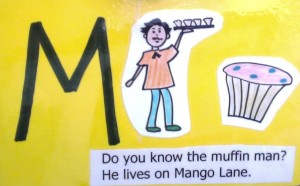
By Liz Buchanan
Singing and chanting are one of the best ways to help young children learn certain early literacy skills, such as distinguishing letter sounds. Singing is fun and engaging for both children and adults. Check out the research (below) that shows the important connections between music and literacy learning. Here are some ideas for making that happen:
Sing regularly with your child or in your classroom. Make a list of songs you remember from when you were growing up and start singing them again. You’ll probably remember songs a lot better than most things you learned when you were little. That’s the nature of music, and why it’s so great for learning. If you want to add songs to your collection, try a web page such as Songs for Teaching. Songs are a natural way to teach rhymes and vowel sounds, build vocabulary and teach about stories and narrative. If you speak another language, sing your favorite childhood songs in that language!
Play rhyming games. Songs are an especially fun way to learn about rhymes, since most children’s songs feature rhymes. Making rhymes helps build phonological awareness, which is the awareness of distinct sounds in language. Here are some songs that help children initiate rhymes:
“Down By the Bay” (on Songs for Teaching)
“Alligator Pie” (poem by Dennis Lee, turned into a song by Joanne Hammil)
“Dr. Knickerbocker” (my song & lesson plan available at Songs for Teaching)
Play with starting consonant sounds through alliteration activities. “Peter Piper Picked a Peck of Pickled Pepper” is a classic alliteration tongue-twister using the letter ‘P.’ Say simple rhymes with children such as “Pease Porridge Hot” and ask how many ‘P’ sounds are in the rhyme.
I use a couple of songs regularly to teach alliteration skills. One is my version of “Two Little Robins,” which you can read more about on The Children’s Music Network blog.
 I also have written my own version of “The Muffin Man,” adding new verses for characters with different starting consonant sounds, such as the Lemonade Lady, the Donut Dog and the Cookie Cat.
I also have written my own version of “The Muffin Man,” adding new verses for characters with different starting consonant sounds, such as the Lemonade Lady, the Donut Dog and the Cookie Cat.
Here are three key studies that show positive links between music and early literacy learning:
1. Children who could tap a regular rhythm achieved greater success at phonological awareness activities.1
2. Children who had regular music instruction scored better on pre-reading assessments.2
3. Children who were taught pre-reading skills using music had higher assessment scores than those in classes that didn’t use music.3
1. David, D., Wade-Wodley, L., Kirby, J., and Smithrim, K. (2007). Rhythm and reading development in school-age children: a longitudinal study. Journal of Research in Reading, 30 (2), 169-83.
2. Gromko, J. (2005). The effect of music instruction on phonemic awareness in beginning readers. Journal of Research in Music Education, 53(3), 199-209.
3. Fisher, D. (2001). Early language learning with and without music. Reading Horizons, 42(1), 39-49.





Great blog, Liz! I’m going to give my Music Together families a link to read it!
Sing on,
Amy
I love both the look and the content of this Blog– playful, fun look with real quality information. Thanks, Liz!